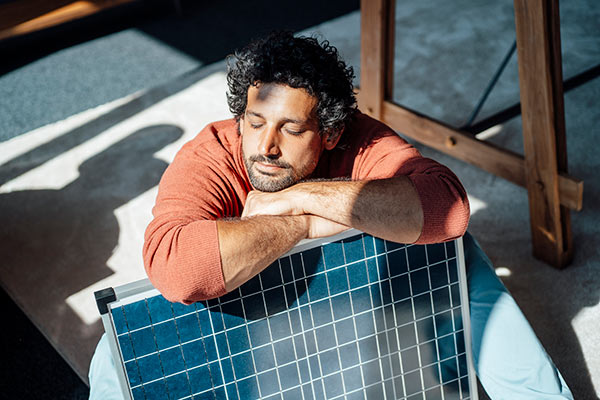Will the ‘new king of electricity’ deliver lavish returns?
6th July 2023 11:44
by Nina Kelly from interactive investor
Solar power is tipped to become the largest source of power capacity in the world. Here’s how your investment portfolio can gain exposure to this high-yield sector.

In her book 15 Million Degrees, British solar physicist Lucie Green explains that it takes a photon 170,000 years to travel from the sun’s core – which is the temperature of the book’s title - to the solar surface, and about eight minutes to travel the 93 million miles to Earth. Green makes the extraordinary point that the light reaching you now “began its journey when Homo sapiens were still considering evolving into modern humans”.
The sun scientist describes the photons’ journey out into the Solar System as “a Herculean task”, since “the extreme temperature in the centre of the Sun means that the atoms within it are torn apart into a plasma”, which is often referred to as the fourth state of matter. Photons find it very difficult to break through this plasma and undergo billions of collisions, known as ‘scattering’, on their journey out of the core. Each scattering event is “as likely to send the photon back towards the centre of the sun as it is to send it up towards the surface”, Green explains. Eventually, 170,000 years later, the photons escape and are the light that is allowing you to read this fascinating article.
- Invest with ii: Buy Investment Trusts | Top UK Shares | Open a Trading Account
Solar energy made up 4.4% of the UK renewable mix in 2022, but solar power can satisfy more than 25% of total energy demand during the summer.
“With more than 14 hours of daylight each day between May and August, it’s a great time to generate renewable electricity – which can also be stored and used when less is being generated,” says Gareth Simkins of Solar Energy UK, a trade association representing the solar and energy storage value chain.
Global solar photovoltaic capacity is set to almost triple over 2022-27, surpassing coal and becoming the largest source of power capacity in the world, according to the International Energy Agency (IEA). Executive director Fatih Birol has dubbed solar power “the new king of the world's electricity markets”.
Last month, London was the venue for the annual UK Solar Summit. Topics considered by the industry included the difference digitisation and artificial intelligence (AI) are making, as well as changing taxation and windfall taxes.
Demand for solar power is driven by the global mission to decarbonise to meet net-zero climate goals, and by energy security fears sparked by Russia’s invasion of Ukraine. But when the sun doesn’t shine, and if climate change impacts on solar energy, what happens? Sarah Feron says that “photovoltaic power outputs change with climate; for example, changes in the frequency of warm cloudy conditions can substantially alter PV energy yields”. The Stanford academic suggests “understanding the response of the PV power outputs to changing climate regimes is crucial” for the energy transition, but she is hopeful that “most of the challenges posed by the enhanced weather variability can be overcome by technical improvements and proper planning”.
- Should you bookmark this small-cap with record growth?
- Merryn Somerset Webb: the scariest chart in the world
- How to prepare your portfolio for the new era of spikeflation
Solar generation works well in tandem with other renewable energy sources, such as wind, argues Chris Hewett, chief executive of Solar Energy UK. “During sunny weather, it’s typically not windy, so when there’s not enough wind to turn the turbines, solar can help make up that difference – and vice versa,” he says.
Those who question the efficacy of solar panels in extreme heat are given short shrift. “Cooler weather is marginally better for efficiency, but ultimately more light means more power. Solar power works perfectly well in the Saudi Arabian desert – and the same panels are being installed there as on rooftops in Birmingham or a field in Oxfordshire,” says Hewett.
The BBC recently covered a report detailing the wind and solar power boom in China, where “solar panel installations alone are growing at a pace that would increase global capacity by 85% by 2025.” The report, by independent research group the Global Energy Agency, reveals that China holds the top position for both wind and solar energy, with each accounting for more than one-third of the world’s total cumulative installed capacity.
Manufacturing capacity for solar panels has increasingly moved out of Europe, Japan, and the US over the past decade and into China, according to the IEA. China’s share in all the key manufacturing stages of solar panels exceeds 80% today, according to IEA report Solar PV Global Supply Chains. And for key elements, this is set to rise to more than 95% in the coming years. The concentration of manufacturing in China may be a concern for some investors given the tensions between Beijing and the West.

Solar power plant in Qinghai province, northwest China
Another negative headwind for solar energy is the government’s extension of the energy windfall tax beyond oil and gas companies to “low-carbon electricity generators”. Starting in January, the tax is levied at 45% on excess profits for electricity generated in the UK.
However, in an article we published in November, investment trust analysts atNumis said:“With the confirmation of the windfall tax in the Autumn Statement there is now more clarity, and assuming our initial post-budget NAV [net asset value] estimates are correct (crude though they are), we believe the impact on NAV is less than the market had been anticipating in many cases.”
The government’s windfall tax imposition may give investors contemplating clean energy cold feet, or push them to look overseas when it comes to investing in solar.
A more pressing concern for income-hungry investors eyeing solar energy is rising interest rates.
Alternatives in your portfolio
As well as being a source of diversification within a portfolio, alternative assets such as infrastructure and renewable energy can offer investors consistent and inflation-linked income, even during a recession.
But, as interest rates rise, as they are doing now, the yields on low-risk government bonds increase too. It’s at this point that those who are investing for income may be tempted to simply buy bonds instead of opting for riskier returns on offer from investment trusts whose yields may be only slightly higher.
Higher interest rates also mean that debt becomes more expensive, which is how some trusts, for example, purchase new assets.
- Investors expecting to make returns comfortably ahead of inflation in 2023
- Cash or shares? What the data tells us about where to invest
However, given sticky inflation and the long-term trend to decarbonise, now could be a good time to take advantage of opportunities in this field. UK-focused Bluefield Solar Income Fund (LSE:BSIF), with a dividend yield of 6.9%, is trading at a discount of 13.3% at the time of writing, while NextEnergy Solar (LSE:NESF), also UK-focused,has a dividend yield of 7.9% and is trading on a 17.6% discount.

Here comes the sun: options for investing in solar energy
There are shares, exchange-traded funds (ETFs), open-ended funds and investment trusts available for investors seeking exposure to solar energy, from pure-play specialists to diversified options, which dilute the risk that comes with investing in a niche area.
Asset manager Foresight Group, for example, has several options for retail investors interested in the solar energy theme.
One is the largest UK-listed dedicated solar energy investment companyForesight Solar (LSE:FSFL), which is currently yielding 7.2% and trading on a discount of 20.7%. The FTSE 250-listed investment trust owns solar parks in the UK, Australia and Spain, and battery storage assets. We recently reported on a director purchase of shares in Foresight Solar, which is approaching its 10-year anniversary. It had a record-breaking year in 2022, benefiting from higher power prices, inflation hitting a 40-year high, and high irradiation in the UK.
I interviewed Bernard Fairman, founder and CEO of asset manager Foresight Group, two years ago this summer. Fairman said at the time of the interview: “Solar is very reliable. It may not feel so as you go out and it rains and the weather’s bad, but year after year, solar is very predictable, the income is very predictable.”
- The funds and trusts that can’t be replaced with an ETF
- Have the big super-trends for the next decade changed since Covid?
For circumspect investors with an eye for diversification, there is a range of investment trusts within the Association of Investment Companies’ ‘Renewable Energy Infrastructure’ sector, such as Foresight Group’s FTSE 250 JLEN Environmental Assets (LSE:JLEN), which invests in other sources of power beyond solar and wind. For more cautious investors, it’s hard to forget Hewett’s comment about how solar generation works well in tandem with other renewables when the sun isn’t shining.
As with any investment theme, it’s not all sunlit uplands. interactive investor columnist Ian Cowie wrote recently about his experience of holding the US Solar Fund (LSE:USF) in his globally diversified portfolio and his disappointment in the investment. Mitigating our columnist’s pain is the fact that the trust comprised only 2% of his ‘forever fund’. The size of the holding illustrates the wisdom of limiting exposure to any one theme to avoid getting your fingers burned.
These articles are provided for information purposes only. Occasionally, an opinion about whether to buy or sell a specific investment may be provided by third parties. The content is not intended to be a personal recommendation to buy or sell any financial instrument or product, or to adopt any investment strategy as it is not provided based on an assessment of your investing knowledge and experience, your financial situation or your investment objectives. The value of your investments, and the income derived from them, may go down as well as up. You may not get back all the money that you invest. The investments referred to in this article may not be suitable for all investors, and if in doubt, an investor should seek advice from a qualified investment adviser.
Full performance can be found on the company or index summary page on the interactive investor website. Simply click on the company's or index name highlighted in the article.